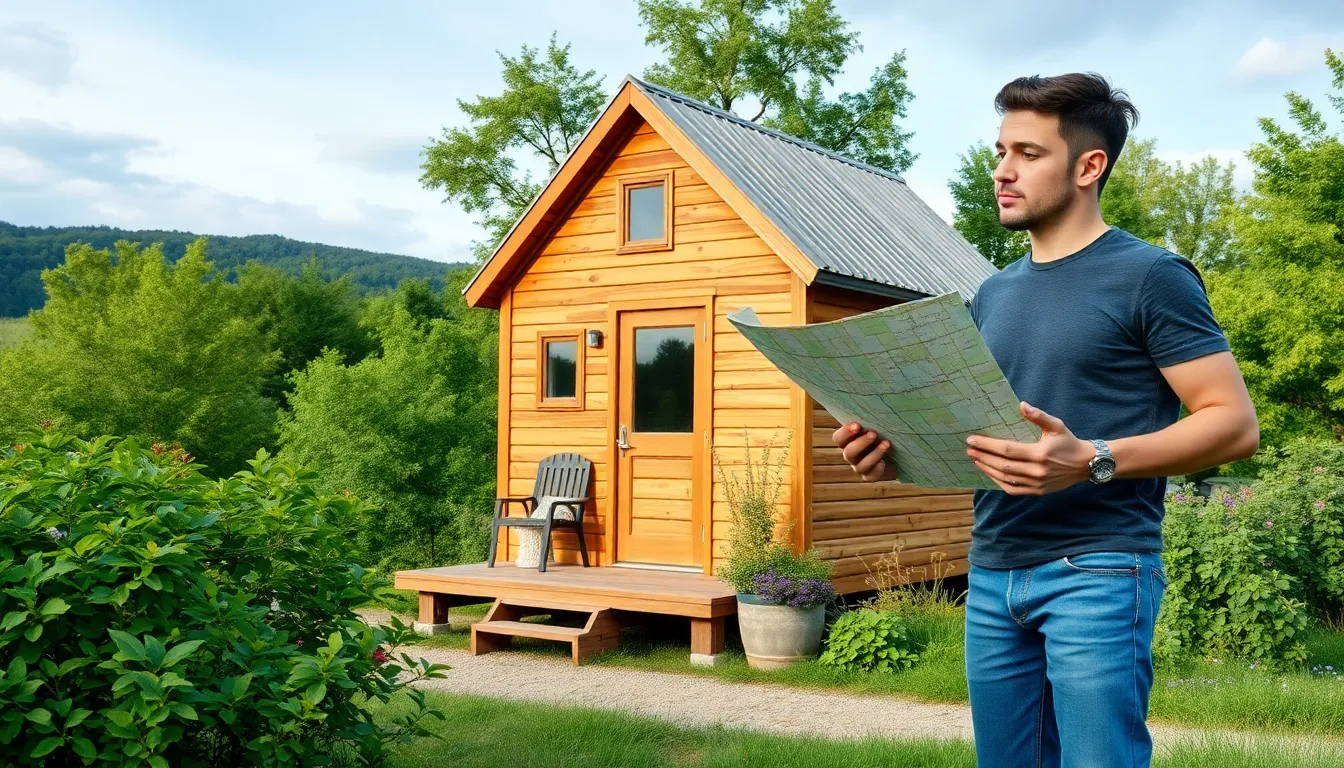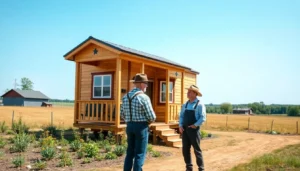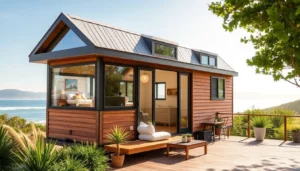Table of Contents
ToggleTiny homes are all the rage, and for good reason. They offer a cozy, minimalist lifestyle that’s both affordable and eco-friendly. But before diving into the world of pint-sized living, one must navigate the often perplexing maze of tiny home zoning laws. Think of it as a game of Monopoly where the rules keep changing, and the properties are just a tad too small for a traditional hotel.
Zoning laws can feel like a bureaucratic monster lurking under the bed, ready to pounce on unsuspecting tiny home enthusiasts. From setbacks to occupancy limits, these regulations can make or break the dream of downsizing. Understanding the ins and outs of these laws can mean the difference between a blissful tiny retreat and a legal nightmare. So buckle up and get ready to explore the wild world of tiny home zoning—because who knew living small could come with such big challenges?
Overview Of Tiny Home Zoning Laws
Tiny home zoning laws vary significantly by location. Local governments often dictate the regulations governing where tiny homes can be placed. Some areas classify tiny homes as recreational vehicles, while others recognize them as permanent residences. Specific zoning classifications can include residential, agricultural, or mixed-use designations.
Many cities impose minimum square footage requirements for dwellings, affecting tiny home feasibility. For instance, a city might mandate homes to be at least 1,200 square feet, excluding tiny home options. It’s essential to research local regulations before investing in a tiny home.
Building codes also play a vital role in tiny home construction. Compliance with state and local building codes ensures safety standards are met. These codes may cover aspects such as electrical systems, plumbing, and structural integrity. Violations often lead to fines or the inability to occupy the home.
In some regions, tiny homes can be parked on private property or in designated communities. Tiny home villages specifically allow multiple tiny homes, promoting community living. Adherence to community rules and local zoning laws remains necessary for success.
Permitting processes often prove complex, and additional requirements may arise. Applicants could face inspections, zoning board hearings, or other hurdles. Consulting with local authorities boosts understanding of specific requirements associated with tiny home projects.
Overall, comprehending tiny home zoning laws is crucial for securing the ideal location. Each jurisdiction approaches these laws differently, emphasizing thorough research before making any moves.
Importance Of Understanding Zoning Laws
Understanding zoning laws is essential for anyone considering a tiny home. These regulations govern where tiny homes can be placed, what features they can have, and how communities can accept them.
Legal Definitions
Zoning laws include specific legal terms that define residential and commercial properties. Local governments classify tiny homes differently, often categorizing them as either permanent residences or recreational vehicles. Each classification comes with its own set of rules and requirements. Knowledge of these definitions helps aspiring tiny homeowners comprehend what is allowed in their area. Some regions enforce minimum square footage, influencing whether a tiny home qualifies within a specific zone. Additionally, definitions of comprehensive plan policies might dictate overall development goals, impacting tiny home placements within broader community plans.
Impacts On Tiny Home Living
Zoning laws directly affect the feasibility of tiny home living. Regulations dictate locations where tiny homes can reside, significantly influencing affordability and accessibility. Communities that embrace tiny homes might provide designated lots or organized villages, fostering supportive environments. Without compliance, homeowners risk fines or being forced to relocate. Restrictions can limit design choices, affecting the overall living experience and aesthetic appeal. Those who understand zoning laws can navigate restrictions effectively, ensuring their tiny home dreams become reality while abiding by local regulations.
Variations In Zoning Laws By State
Tiny home zoning laws differ significantly across states. Local regulations dictate how tiny homes can be classified and permitted, influencing the ease of establishing a tiny living environment.
Examples Of Progressive States
California offers several cities promoting tiny home living, including Los Angeles and Santa Barbara. Oregon recognizes tiny homes as permanent residences, leading to more supportive zoning regulations. Colorado has embraced tiny home communities, with various municipalities establishing guidelines that encourage their development. Florida allows tiny homes in designated areas, focusing on eco-friendly living. These examples showcase the flexibility of zoning laws in progressive states, which often aim to support sustainable housing solutions.
States With Restrictive Regulations
Texas presents challenges, with many municipalities maintaining strict definitions that classify tiny homes as recreational vehicles. New York imposes substantial square footage minimums, limiting options for those seeking tiny homes. In Illinois, zoning laws often favor traditional housing, hindering tiny home construction. Pennsylvania features restrictions that complicate tiny home placement, requiring extensive permitting processes. These restrictive regulations highlight the difficulties faced by tiny homeowners in certain states, emphasizing the need for thorough research.
Challenges Faced By Tiny Homeowners
Tiny homeowners encounter numerous challenges stemming from zoning laws, impacting their lifestyle choices and housing opportunities.
Common Zoning Issues
Zoning classifications often create significant hurdles for tiny homeowners. Many local governments categorize tiny homes as recreational vehicles, restricting them from being used as permanent residences. Specific minimum square footage regulations frequently exclude tiny home designs. Some municipalities impose stringent restrictions that prevent placement on residential lots, limiting options for aspiring owners. Access to utilities can become problematic as certain areas lack the infrastructure to support tiny homes. Compliance with community ordinances also poses a challenge; violations may lead to fines or relocation, making it crucial to thoroughly research zoning laws.
Navigating Local Government Regulations
Local government regulations significantly affect tiny home placement and construction. Obtaining permits often involves intricate processes, including inspections and hearings that can delay projects. Awareness of varying local laws is essential, as each jurisdiction dictates unique requirements for tiny homes. Engagement with local authorities proves vital in clarifying essential criteria and understanding restrictions. Some communities actively push for more supportive tiny home policies, while others enforce restrictive measures. By staying informed about regulatory changes, tiny homeowners can better navigate these complexities, turning their vision into reality.
Potential Solutions And Advocacy
Advocacy plays a vital role in addressing tiny home zoning issues. Individuals and communities can come together to influence regulations and promote tiny home acceptance.
Community Engagement
Promoting community engagement cultivates support for tiny homes. Local forums and community meetings provide platforms for discussions around zoning laws and tiny home standards. Residents can express their concerns and share success stories from existing tiny home projects. Engaging with neighborhood associations helps foster understanding and creates a welcoming atmosphere for tiny living. Collaborative efforts with local businesses can also highlight the benefits of tiny homes, such as increasing affordable housing options while supporting sustainability initiatives.
Legislative Changes
Pursuing legislative changes proves essential for advancing tiny home rights. Advocacy groups can work with local governments to reform zoning laws that restrict tiny home use. Encouraging lawmakers to introduce flexible zoning classifications allows for innovative housing solutions. Crafting model legislation can guide municipalities in adopting supportive regulations. Noteworthy examples exist in states like California and Oregon, where progressive policies facilitate tiny home development. Legislative efforts targeted at removing minimum square footage requirements can significantly enhance tiny home feasibility across varying communities.
Conclusion
Navigating tiny home zoning laws is essential for anyone looking to embrace this unique lifestyle. The complexities of local regulations can significantly influence the success of tiny home projects. By understanding these laws and engaging with local authorities, potential homeowners can better position themselves to achieve their tiny living dreams.
Advocacy and community involvement play vital roles in shaping more accommodating zoning policies. As more people advocate for flexible regulations, the future of tiny homes looks promising. With knowledge and persistence, aspiring tiny homeowners can find the right path to make their vision a reality while ensuring compliance with local guidelines.








